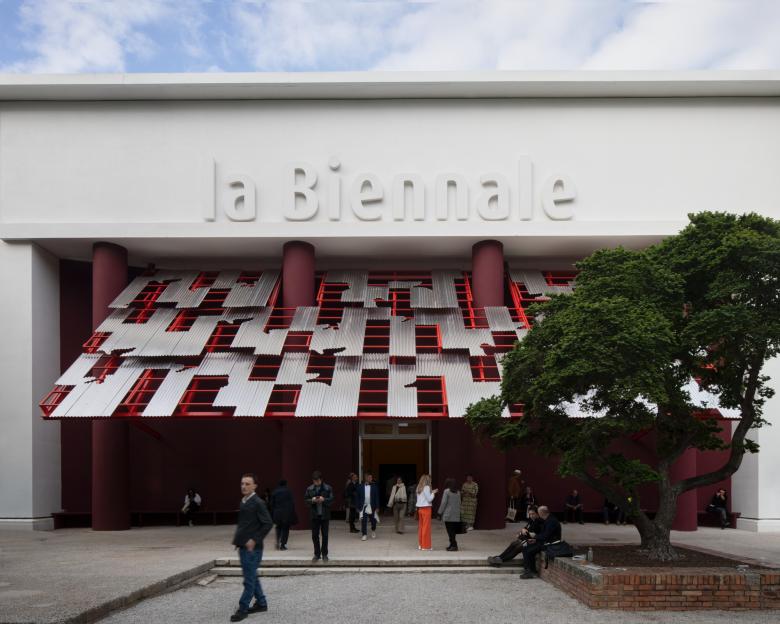8. May 2024
The Central Pavilion during the 2023 Venice Architecture Biennale; the venue in the Giardini will be closed for renovation in 2025. (Photo: Flavia Rossi)
Five months after Italy's Carlo Ratti was named curator of the Venice Architecture Biennale that is set to open in May 2025, Ratti and new Biennale President Pietrangelo Buttafuoco have revealed the exhibition theme: Intelligens.
The title of the 19th International Architecture Exhibition, which doubles as the exhibition's theme, was announced yesterday in Venice. At first glance Intelligens looks like a misspelling of or play on the word “intelligence,” but Ratti explains that it is a condensation of words from English and Italian: “The title Intelligens is linked to the modern term ‘intelligence,’ but it also evokes a wider set of associated meanings. In fact, the final syllable, ‘gens’ is Latin for ‘people.’ A new, fictional root emerges, suggesting a future of intelligence that is inclusive, multiple, and imaginative beyond today’s limiting focus on AI.”
Buttafuoco, in his statement, contributes further linguistic obfuscation, writing the title as Intelli/Gens and saying: “Meaning and sign converge in the title Intelli/Gens. While intelligence is the foundation of the individuals’ process of evolution, in the most noble sense of their being cives (a third declension noun, thus both masculine and feminine), architecture is the space in which it can unfurl, in a constant negotiation with the territory. Enumerating functions, drawing symbologies, fostering relationships, intelligence builds architecture in ethical, aesthetic and above all ecological terms. It is a fact that, etymologically, oikos in Greek means home but also environment.”
In actuality, the full title of the exhibition is Intelligens. Natural. Artificial. Collective. The terms following Intelligens will serve to structure the objects, buildings, urban plans, and other contributions to the exhibition come May 2025. Further explaining the theme, Ratti said the exhibition “will be about the built environment and the many disciplines that shape it. Architecture is at the center but not alone. It is part of an extended sphere that integrates art, engineering, biology, data science, social and political sciences, planetary systems sciences, and other disciplines — linking each and all of them to the materiality of urban space.”
Carlo Ratti at the World Economic Forum in 2016 (Photo: Faruk Pinjo © World Economic Forum, via Flickr)
The integration of other disciplines outside of architecture into an architecture exhibition is not surprising given that, in addition to being a practicing architect, Ratti, who was trained as an architect and engineer, directs MIT's Senseable City Lab, a research group that investigates how digital devices impact urban living, and he is responsible for numerous inventions, including Scribit, a whiteboard-writing robot. But given the outsized role of buildings in the contribution to global carbon emissions, Ratti gives architecture prominence over other fields, contending that “architecture [is] among the main culprits in the degradation of our planet.”
Sounding more than midly sci-fi, the exhibition “will cast architects in the role of ‘mutagens’ stimulating natural evolutionary processes and sending them off in new directions” to create “design proposals and many other experiments, exploring a definition of ‘intelligence’ as an ability to adapt to the environment with limited resources, knowledge, or power.” Ratti foresees that some of the ideas generated by the theme “are destined to fail, [but] others may point us toward redemption.”
With recent Biennales foregrounding, among other things, building fundamentals (Rem Koolhaas in 2014), socially engaged projects (Alejandro Aravena in 2016), and the overlooked contributions of Africa and the African diaspora (Lesley Lokko in 2023), Intelligens promises to be the most tech-heavy and science-inflected architecture exhibition in Venice since Kurt W. Forster's Metamorph in 2004 and Aaron Betsky's Out There: Architecture Beyond Building in 2008.
The announcement of the title/theme also defines the “four methodological pillars” that Ratti's exhibition are founded on. Most surprising, at least to this writer, is the closing of the large Central Pavilion in the Giardini for renovation, a situation that will force the display of contributions to happen elsewhere, be it on the Biennale grounds or across Vencie. The four pillars, per yesterday's announcement:
- Transdisciplinarity: architectural projects will be collaborations between multiple professionals, with the objective of advancing scientific knowledge whenever possible.
- Living Lab: as the Central Pavilion at the Giardini will be under renovation in 2025, it will be replaced by a number of special projects that will leverage Venice and the outdoor areas of the Biennale Exhibition venues as a Living Lab, merging interacting forms of intelligence.
- Space For Ideas: at a time of crisis, we need to embrace a collaborative approach to design. As of May 7, 2024, a public venue for the submission of ideas is open on the website of La Biennale, fostering an expansive heterogeneity of voices, visions, and suggestions.
- Circularity Protocol: the Exhibition aims to set unprecedented goals for circularity. A Circularity Manifesto will be developed to define clear directions and a new standard for the future of cultural events.
Lastly, although the participating national pavilions typically have the free choice of following the theme of the main International Architecture Exhibition or pursuing another theme determined by their own curators (outside of Rem's 2014 “Absorbing Modernity” mandate), Ratti is “encouraging” the participating countries to "address the common prompt of ‘One place, one solution,’ ‘showcasing how local ingenuity can address our time’s existential challenge that can only be tackled in a cooperative manner, reflecting a multiplicity of approaches. If every country brings one success to the table, together we can assemble a global kit for adapting to the future.’ Given that, with exactly one year to go until the 2025 Venice Architecture Biennale opens, numerous countries have already chosen their curators and started the process for developing their pavilions, so it remains to be seen if they heed Ratti's call for each place to offer one solution.
Related articles
-
Redefining Boundaries with Carlo Ratti
on 7/8/24
-
And the 2025 Biennale Theme Is …
on 5/8/24

